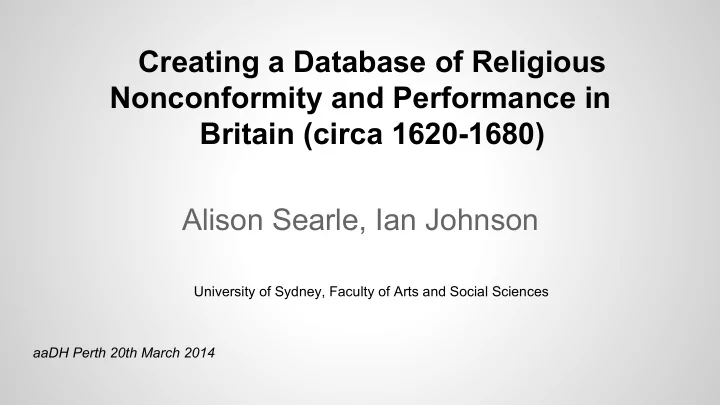

Creating a Database of Religious Nonconformity and Performance in Britain (circa 1620-1680) Alison Searle, Ian Johnson University of Sydney, Faculty of Arts and Social Sciences aaDH Perth 20th March 2014
Overview of the project Photograph: ‘James Nayler Commemoration’, British Radical History Group, 2006, http://www.brh.org.uk/site/ articles/bristol-radical- history-week-2006-james- Images: ‘James Nayler Commemoration’, British nayler-commemoration/ Radical History Group, 2006, http://www.brh.org.uk/ site/articles/bristol-radical-history-week-2006- james-nayler-commemoration/
Key concepts in theoretical approach: • Spectator/witness • Space • Dissimulation • Conversion • Belief
Questions arising from our collaboration: • How does one define an ‘event’ in bibliographical and performance terms? • Can a digital entity such as ‘event’ transcend the traditional distinctions made in humanities research between the process of print publication and the performance of a sermon or play? • What types of agents were involved in different kinds of events over the chronological period under consideration (1620-1680)? • What do non-linear, non-narrative forms of data-modelling add to our understanding of the early modern period and the theoretical and historical concepts we use to explore and recreate it?
Image 2: Luke Blaney, Blayney's theatre ontology ‘Theatre Ontology’, http://lukeblaney.co.uk/ semweb/theatre Image 1: Luke Blaney, ‘A diagram of the Theatre Ontology’, http://lukeblaney.co.uk/ projects/bedlam Image 3: Luke Blaney, ‘Theatre Ontology Update’(Cultural Hackday 2011)’, http:// blog.lukeblaney.co.uk/post/2997802925
Two successful digital projects focusing on the early modern period that act as catalysts, rather than models include: • The attempt to recreate the experience of hearing a sermon by John Donne at St Paul’s Cross, London: http://vpcp.chass.ncsu.edu/framework/ • The interactive Map of Early Modern London which links an online map with sources, encyclopedia entries, organisations and a bibliography: http://mapoflondon.uvic.ca/
Geographical and Spatial ‘Turn’ Julie Sanders, The Cultural Geography of Early Modern Drama (CUP, 2011) Kristen Poole, S upernatural Spaces in Shakespeare’s England: Spaces of Demonism, Divinity, and Drama (CUP, 2011)
FRBR Functional Requirements for Bibliographic Records (IFLA 1998) What is FRBR? A Conceptual Model for the Bibliographic Universe. Barbara Tillett Technicalities 2003, Vol 25, no. 5 http://www.loc.gov/cds/downloads/FRBR.PDF Final report, revised Feb 2009 http://www.ifla.org/files/assets/cataloguing/frbr/frbr_2008.pdf The FRBR Family of Conceptual Models: Toward a Linked Future. Special issues, Cataloguing and Classification Quarterly 2012, Vol 50, issues 5-7 Luke Blayney (Culture Hack Day 2011) moving towards FRBR Image: ‘Group 1 entities and basic relations’, Functional • Requirements for Bibliographic Records, Wikipedia, Instead of a Show class, the ontology now refers to FRBR 's Work class • http://en.wikipedia.org/wiki/ A move away from the use of foaf:Project in favour of FRBR terms. Functional_Requirements_for_Bibliographic_Records
Overall Structure
Summary of record types and content Lv 1 Work Work Lv 2 Expression Expression Lv 3 Manifestation Document set Performance set Lv 4 Item Simplified item Document Performance ● We have found it unnecessary to differentiate performance and document streams at the Work and Expression level ● For pragmatic reasons we have introduced a Simplified item which telescopes the Work- Expression-Manifestation-Item stack for singular events and one-off documents
Other components • 2nd level entities - persons, corporate bodies • 3rd level entities - concept, object, event, place • Other relationships o Relationship Marker fields o ontology in progress, extensible o mappings
1. Work Textual Event
2. Expression Event Textual
3. Manifestation Performance series
4. Item Performance
3. Manifestation Print series
4. Item Document
4. Simplified item
Technical conclusions test set FRBR-style records • 16,000 digital media several hundred letters to and from Richard Baxter (secure access) o extraction of EXIF metadata o location images (GPS matched) o • Advantages of incremental model building • Publishing the model as a template • Retrieval - search, mapping, web publishing
Retrieval, searching, mapping
Strengths and limitations of Template/ Future Directions • Strength - ability to map different kinds of relationships between entities in a flexible, yet theoretically robust way • Weakness - a far more intensive process of data-entry and mark-up than initially anticipated • The database template is not an inefficient attempt to replicate the work done by something like the English Short Title Catalogue, for example. It is a complementary tool. • The database’s mapping of relationships between texts, events and agents promises [qualified by utopias/dystopian elements discussed in first conference plenary!] an innovative and complementary way of thinking about the production of texts, performance, nonconformist religion and drama in early modern Britain.
alison.searle@sydney.edu.au ian.johnson@sydney.edu.au Heurist: HeuristScholar.org Acknowledgements: Australian Research Council DECRA grant Artem Osmakov, Programmer, University of Sydney
Recommend
More recommend